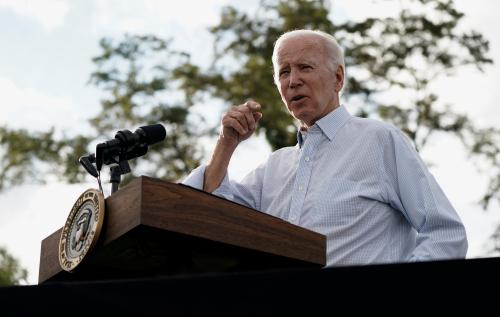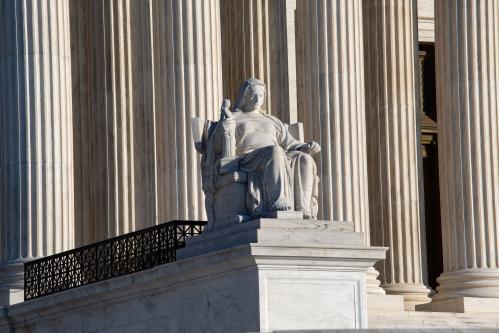Hallmarks of first-year Biden judicial appointees were their diversity but also their sheer number— more first year appellate and district court appointments than any president since JFK. Biden’s end-of-two-year numbers will outpace most of his recent predecessors.
To reach record confirmations for Biden’s four-years, Senate Democrats—some facing tough 2024 races—will need to maintain party unity and avoid temporary or permanent reductions in their 50 or 51 vote majority from illness or worse. And opposition senators have ways of slowing and sometimes scuttling nominations and confirmations.
However those factors play out, three additional factors will challenge Biden’s ability to top Donald Trump’s four-year record of 231 appointments—54 court of appeals (circuit) judges and 177 district judges. Those factors will also make it almost impossible for Biden to reverse the shift Trump accomplished in the courts of appeals’ party-of-appointing-president composition. The factors are the paucity of projected vacancies, who’s likely to create the vacancies, and the administration’s disinclination so far to fill district vacancies in red and purple states.
Recent Presidents’ Third- and Fourth-Year Confirmations
Tables A and B compare the six most recent presidents’ first-and-second, and third-and-fourth, year confirmations. Reagan, for example, appointed 10% fewer judges in 1983 and 1984 than he did in 1981 and 1982. The Senate confirmed 98% of his nominees in his first stint and 83% in his second. Biden’s two-year confirmations—87 as of December 5—will change through the month with lame-duck confirmations.
TABLE A—District and Circuit Judge Confirmations in First and Second Two-year Stints
| Four-year Total | Years 1-2 | Years 3-4 | % change | |
| Reagan | 165 | 87 | 78 | -10% |
| Bush | 191 | 70* | 121* | 70% |
| Clinton | 201 | 126 | 75* | -43% |
| Bush | 204 | 100* | 104 | 4% |
| Obama | 171 | 60 | 111 | 85% |
| Trump | 231 | 83 | 148 | 78% |
| Biden (12/05) | N/A | 87 | N/A | N/A |
Asterisk indicates divided government
TABLE B—Comparative Confirmation Rates
| Four Year Total | Years 1-2 | Years 3-4 | |
| Reagan | 165 | 87 (98%) | 78 (83%) |
| Bush | 191 | 70* (93%) | 121* (69%) |
| Clinton | 201 | 126 (90%) | 75* (77%) |
| Bush | 204 | 100* (77%) | 104 (82%) |
| Obama | 171 | 60 (58%) | 111 (73%) |
| Trump | 231 | 83 (54%) | 148 (85%) |
| Biden (12/05) | N/A | 87 (62%–in flux) | N/A |
Asterisk indicates divided government
Four of the six presidents had more confirmations in their second than in their first stints, and the most recent three had higher confirmation rates as well. The first Bush’s greater third-fourth year confirmations but lower confirmation rate reflect his limited success in filling an influx of vacancies that Congress created at the outset of his third year. Clinton benefitted from leftover vacancies, but his numbers and rate dropped after Democrats lost the Senate in 1995. George W. Bush, Obama, and Trump outperformed in their second stints partly because the Senate confirmed judges through December of the fourth year, rather than October.
Biden’s Four-Year Confirmations
In 2023-24 Biden can probably top the confirmation rates of his first two years. But the number of confirmations depends partly on available vacancies. Changing the party-of-appointing-president balance on the courts depends partly on who creates the vacancies. Party-of-appointing-president is a modest (but about the best readily available) aggregate predictor of judicial voting in ideologically charged cases.
Courts of Appeals
While Biden’s total first- and second-year circuit appointees will top all predecessors (except perhaps Trump’s 30), Biden’s impact on the court of appeals ideological make-up has been modest and will stay modest.
Table C shows how Trump changed the composition of the 179-judgeship courts of appeals over four years, the changes Biden has effected to date, and one possible four-year outcome.
TABLE C—Courts of Appeals Changes
| As of: | Rep. Appointees | Dem. Appointees | Vacancies |
| Jan. 2017 | 71 (40%) | 91 (51%) | 17 (10%) |
| Jan. 2021 | 96 (54%) | 80 (45%) | 3 (2%) |
| Nov. 2022 | 91 (51%) | 79 (44%) | 9 (5%) |
| Dec. 2024 (projected | 91 (51%) | 88 (49%) | 0 |
Row percentages may not total 100 due to rounding
Since Biden took office, Republican-appointed judges in active status have dropped from 96 to 91 (from 54% to 51% of statutory judgeships), but the number of Democratic appointees has also dropped, and the number of vacancies has increased.
Biden has replaced only four Republican appointees (including one Democrat appointed in a deal). By contrast, in Trump’s first two years, 11 of his 30 circuit appointees replaced Democratic appointees; over four years, 19 of his 54 appointees did so. (Trump benefitted from the near-total shutdown of confirmations in Obama’s final two years in office. Nine of the 17 vacancies Trump inherited were over a year old. Had Obama been able to fill them, Trump likely would have appointed only 21 circuit judges in his first two years, replacing six rather than 11 Democratic appointees.)
Not surprisingly, other-party appointees have resisted retirement under Biden. Since his election, 25 Democratic appointees have retired or resigned, versus five Republican appointees. In the comparable period after Trump’s election, eight Democratic appointees have done so, versus 17 Republican appointees.
Table D—one simplified scenario of Biden’s full-term court of appeals appointments—shows how Biden might appoint as many circuit judges as did Trump but won’t replace as many other-party appointees.
TABLE D—One Scenario of Biden Four-Year Circuit Appointments
| Appointees | Running Total | Replaced Rep. Appointees | ||
| Confirmations as of 12/5 | 26 | 26 | 4 | |
| (1) | Confirm all pending nominees (during lame duck session and upon resubmission in 2023) | 11 | 37 | 1 |
| (2) | Submit nominees/get confirmations for current and announced vacancies without nominees | 4 | 41 | 2 |
| (3) | Fourteen judges leave active status in time for Biden and the Senate to replace them | 14 | 55 | ? |
(1) Confirming the pending nominees would increase Biden’s total from 26 to 37 and replace a fifth Republican appointee. Of the 11, three are to states with two Republican senators and two are to split-delegation states. Home-state senators can no longer shut down the confirmation of circuit nominees to whom they object—Senate Democrats have continued Republicans’ practice of depriving home-state senators of that prerogative.
But the confirmations in 2022 to Tennessee and Pennsylvania vacancies—to which home-state senators objected (here and here)—took measurably longer than the other 24. For the 24, the median days from nomination to confirmation was 119, although often contentious. For the Tennessee and Pennsylvania confirmations, days were 295 and 253 respectively, highest and second highest among the 26.
Home-state Republican senators apparently support at least three of the five pending red or purple state nominees. But where there is opposition, based at least on experience to date, confirmations may be drawn out and consume time that otherwise could be spent on additional confirmations.
(2) Filling the four current or future vacancies without nominees—one each in Texas and Indiana—would bring the number of Republican appointees Biden has replaced from four to seven.
(3) Additional vacancies will occur as circuit judges leave full-time service (“active status”) and thus create vacancies. Most circuit and district judges wait to leave active status at least until they satisfy “the rule of 80”, a statutory formula combining age and years of service. They keep their judicial salaries as semi-retired “senior judges” (or former judges if they leave the bench).
When the Senate convenes on January 3, 2023, 16 active-status Democratic-appointed circuit judges will meet rule-of-80 criteria, as will 24 Republican appointees. (One more Democratic appointee, and three Republican appointees become eligible by September 1, 2024.)
Table D shows that if 14 judges leave active status in time for Biden to appoint their successors, he could top Trump’s 54 confirmations. But, of the 16 Democratic appointees, three have been rule-of-80 eligible for 10 years, and seven have been eligible for five years. One can only speculate what might incentivize any 14 of the 16 (or, less likely, one or more eligible Republican appointees) to leave active status so Biden could try to appoint successors. Of course, others might leave active status—rule-of-80 eligible or not (eight rule-of-80 eligible active status judges are 80 years or over).
But, unless Biden can replace additional Republican appointees beyond the four so far and three more in process, Republican appointees would still be in the majority at the end of the 118th Congress, as shown in Table C.
District Courts
Two factors distinguish district from circuit judge nominations under Biden. First, probably to avoid hardline bargaining with home-state Republican senators, Biden has eschewed nominations to vacancies in red and purple states. (Home-state senators still have near-veto authority over district nominations.) Of 104 district nominations, only 11 were to red and purple state vacancies—mostly Ohio and Pennsylvania—versus eight of 37 circuit nominations. The median days from district vacancy to nomination for vacancies in Republican-senator states was almost 400—as opposed to 253 for blue states and even less for courts with no senators.
Second, Democratic appointees were already a slim majority of district judges when Biden assumed office. They now constitute 53% of active-status district judges—320 of 599—and that proportion will increase. How much is hard to say, based on the contingencies in Table E.
TABLE E—One Scenario of Biden Four-Year District Court Appointments
| Appointees | Running Total | Replaced Rep. Appointees | ||
| Confirmations as of 12/5 | 61 | 61 | 31 | |
| (1) | Confirm all pending nominees (during lame duck session and upon resubmission in 2023) | 42 | 103 | 22 |
| (2) | Submit nominees/get confirmations for current and announced vacancies without nominees | 61 | 164 | 35 |
| (3) | Fourteen judges leave active status in time for Biden and the Senate to replace them | 14 | 178 | ? |
(1) and (2) may vary slightly from other accounts because of a withdrawn home-state senator support and a withdrawn intention to leave active status
(1) Only two of the 42 pending nominations are to what will be red or purple states in 2023 and, one presumes, have been approved by home-state senators, who still have near veto power over district nominees. (Because the incoming Ohio Republican senator might impose a veto, the lame-duck Senate appears likely to confirm the nominee.) To be sure, home-state opposition is not the only source of contention; a New York and a California nominee who have stirred Republican opposition have been waiting for over 425 days since nomination. The median wait for other pending nominees is 140.
(2) Getting nominees in place for the 61 current or formally announced future vacancies may be complicated. Thirty-nine of the 61 are in states with a Republican senator—the kind of vacancies that Biden has largely avoided. But nominating mainly to blue state vacancies obviously reduces the number of appointments (and reduces the number of appointees who replace Republican appointees: of the 21 blue state (or no senator) vacancies, only eight were created by Republican appointees).
(3) By my count, 35 additional active-status Democrat-appointed district judges are or will be rule-of-80 eligible by January 3, 2023, but only 14 of the 35 have two Democratic (or no) senators, and there’s no certainty that all 14 will leave active status in time for Biden to replace them (six of the 14 have been rule-of-80 eligible for over ten years). However, 16 more Democratic appointees become rule-of-80 eligible by January 2024, and another 19 by September of that year—and the latter two tranches are more heavily dominated by Democrat-or no-senator states. But how many leave active status and how many the administration and Senate can replace are open questions.
Fifty-four active status Republican appointees also are or will be rule-of-80 eligible by January 3, 2023. Republican-appointed district judges have been more likely than their circuit counterparts to leave active status with Biden in the White House.)
In short, to top Trump’s record of 177 district appointees, the administration will need some combination of more nominees for vacancies in red and purple states, as well as more vacancies created by active status appointees in time for the administration and Senate to fill them.
To sum up
The scenarios sketched here are oversimplified. They do not account for vacancies created outside of rule-of-80 retirements, and they assume high confirmation rates and a significant uptick in circuit judge retirements. But they provide a starting look at how 2023-24 may play out.
The Brookings Institution is committed to quality, independence, and impact.
We are supported by a diverse array of funders. In line with our values and policies, each Brookings publication represents the sole views of its author(s).








Commentary
Biden’s record-setting judicial confirmation efforts face three challenges in 2023-2024
December 6, 2022